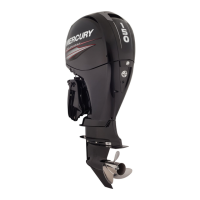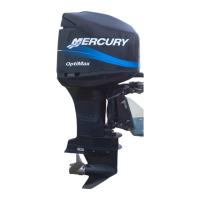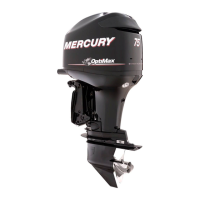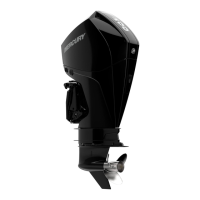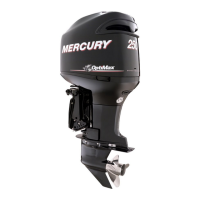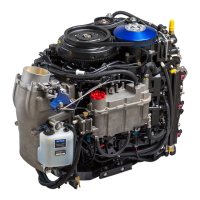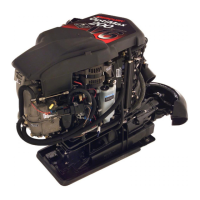DIRECT FUEL INJECTION
90-855347R1 JANUARY 1999 Page 3B-19
rail until an injector opens. A fuel pressure regulator controls pressure in the fuel rails, and
allows excess fuel to return into the vapor separator. The fuel regulator not only regulates
fuel pressure but also regulates it at approximately 10 p.s.i. higher than whatever the air
rail pressure is. The fuel regulator diaphragm is held closed with a spring that requires 10
p.s.i. to force the diaphragm off the diaphragm seat. The back side of the diaphragm is
exposed to air rail pressure. As the air rail pressure increases, the fuel pressure needed
to open the regulator will equally increase. Example: If there is 50 p.s.i. of air pressure on
the air rail side of the diaphragm, 60 p.s.i. of fuel pressure will be required to open the
regulator. The return fuel line to the vapor separator is water cooled.
To equalize the pulses developed by the pumps (both air and fuel) a tracker diaphragm
(3) is installed in the starboard rail. The tracker diaphragm is positioned between the fuel
and air passages. The tracker diaphragm is a rubber diaphragm which expands and re-
tracts depending upon which side of the diaphragm senses the pressure increase (pulse).
Oil
Oil in this engine is not mixed with the fuel before entering the combustion chamber. Oil
is stored inside a standard remote oil reservoir. Crankcase pressure will force oil from the
remote oil reservoir into the oil storage reservoir on the side of the powerhead. Oil will flow
from the oil storage tank into the oil pump. The oil pump is a solenoid design. It is activated
by the ECM and includes 7 pistons with corresponding discharge ports. The oil pump is
mounted directly onto the powerhead. Each cylinder is lubricated by one of the discharge
ports. The oil is discharged into the crankcase. The seventh passage connects to the
hose that leads to the air compressor for lubrication. Excess oil from the compressor re-
turns into the plenum and is ingested through the crankcase.
The ECM will change the discharge rate of the oil pump, depending upon engine demand.
The ECM will also pulse the pump on initial start up to fill the oil passages eliminating the
need to bleed the oil system. The ECM provides additional oil for break in, as determined
by its internal clock. The oil ratio varies with engine rpm and load.
Electrical
The electrical system consists of the ECM, crank position sensor (flywheel speed & crank-
shaft position), throttle position sensor (TPS), MAP sensor, engine temperature sensor,
ignition coils and injectors (fuel & direct). The engine requires a battery to start (i.e. the
ignition and injection will not occur if the battery is dead). The system will run off of the
alternator.
Operation
The operation of the system happens in milliseconds (ms); exact timing is critical for en-
gine performance. As the crankshaft rotates, air is drawn into the crankcase through the
throttle shutters, into the plenum, and through the reed valves. As the piston nears bot-
tom-dead-center, air from the crankcase is forced through the transfer system into the cyl-
inder. As the crankshaft continues to rotate the exhaust and intake ports close. With these
ports closed, fuel can be injected into the cylinder. The ECM will receive a signal from the
throttle position sensor (TPS), engine temperature sensor (TS) and the crank position
sensor (flywheel speed and position sensor). With this information the ECM refers to the
fuel calibration (maps) to determine when to activate (open and close) the injectors and
fire the ignition coils. With the piston in the correct position, the ECM opens the fuel injec-
tor, 90 psi fuel is discharged into a machined cavity inside the air chamber of the air/fuel
rail. This mixes the fuel with the air charge. Next the direct injector will open, discharging
the air/fuel mixture into the combustion chamber. The direct injector directs the mixture
at the bowl located in top of the piston. The piston’s bowl directs the air/fuel mixture into
the center of the combustion chamber. This air fuel mixture is then ignited by the spark
plug.
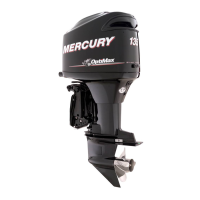
